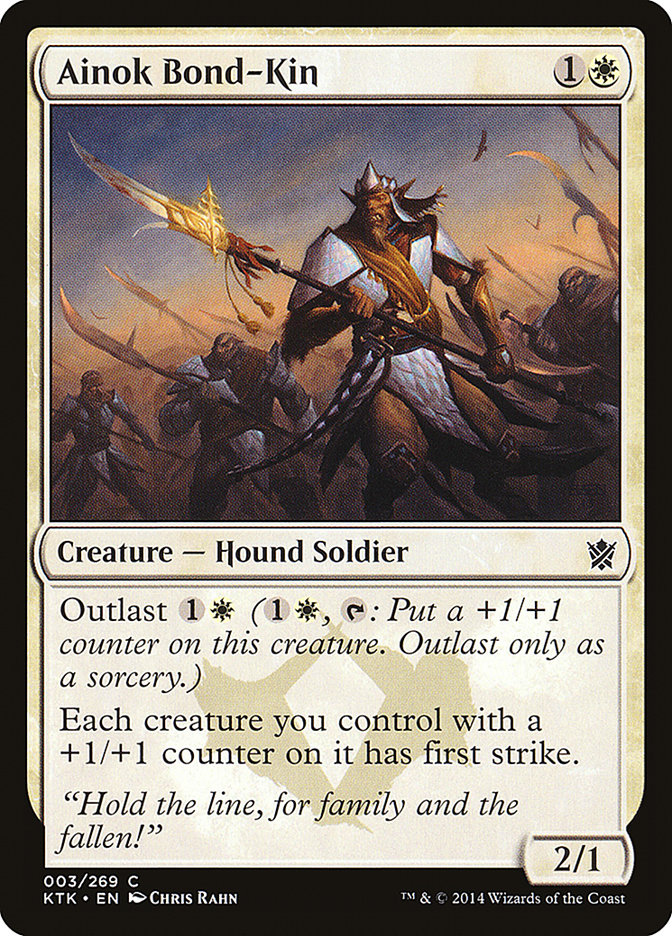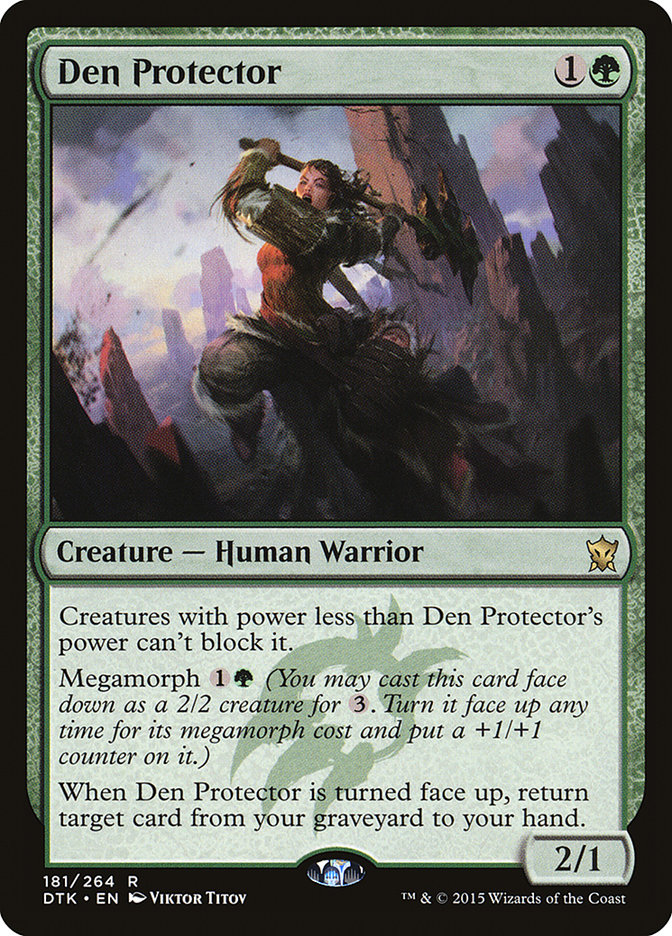Master of Pearls Carta MTG
| Colecciones da carta | Lanzado en 3 coleccionesVer todos |
| El coste de maná | |
| Costo de maná convertido | 2 |
| Rareza | Extraña |
| Tipo | Creature — Human Monk |
| Habilidades | Morph |
| Fuerza | 2 |
| Tenacidad | 2 |
Texto de la carta
Morfología (Puedes lanzar esta carta boca abajo como una criatura 2/2 por . Puedes voltearla en cualquier momento por su costo de morfología.) Cuando el Maestro de las Perlas es volteado, las criaturas que controlas obtienen +2/+2 hasta el final del turno.
Cartas Similares
Master of Pearls es una carta de criatura única en el universo de MTG, con su habilidad de morph que permite a los jugadores una táctica sorpresa que puede cambiar el curso de la batalla. Criaturas con morph como Ainok Bond-Kin, comparten el mismo conjunto y también proporcionan una ventaja en el campo de batalla con Outlast, pero carecen del impacto instantáneo del factor sorpresa de Master of Pearls.
Hidden Dragonslayer es otra carta similar, con su habilidad de Lifelink y poder para destruir a un enemigo fuerte resultando beneficioso. Sin embargo, en lugar de eso, Master of Pearls ofrece un aumento más amplio a todas tus criaturas, potencialmente inclinando todo el campo de batalla a tu favor. Mientras que Hidden Dragonslayer podría proporcionar una solución más enfocada en un objetivo.
Den Protector es digno de mención; al igual que Master of Pearls, también tiene morph, pero en lugar de fortalecer tus criaturas, recupera cartas valiosas de tu cementerio. La utilidad de cada carta es diferente: mientras que Den Protector es fundamental para la recuperación estratégica de recursos, Master of Pearls se trata del elemento sorpresa y de la presencia inmediata en el tablero.
Al evaluar Master of Pearls frente a sus contrapartes, es evidente que aunque hay otras opciones de morphing disponibles, su capacidad para fortalecer inesperadamente a tus criaturas en masa es lo que lo distingue en el juego estratégico de MTG.
Aspectos positivos de la carta
Ventaja de cartas: Master of Pearls proporciona ventaja de cartas potencial al tener dos modos de juego. Cuando se morpha, agrega una criatura al campo, y al voltearse por su costo de morph, mejora todo tu campo, potencialmente cambiando el juego a tu favor.
Aceleración de recursos: Aunque no contribuye directamente a la aceleración de mana, al aumentar el poder de tus criaturas, Master of Pearls te permite finalizar los juegos más rápido, conservando recursos que de otra manera se gastarían en confrontaciones más largas.
Velocidad instantánea: La habilidad de voltear a Master of Pearls a velocidad instantánea permite trucos de combate sorpresa y una ventaja táctica durante el combate. Esto puede interrumpir la estrategia del oponente y permitir victorias inesperadas.
Aspectos negativos de la carta
Requisito de descarte: Una desventaja considerable de Master of Pearls es su dependencia de ser volteada para activar su habilidad. Esto puede complicarte la situación si no tienes el mana necesario disponible, ya que pierdes la oportunidad de usar el potencial completo de la carta.
Costo de mana específico: Master of Pearls requiere mana blanco para lanzarse. Esto puede ser restrictivo ya que encaja principalmente en mazos blancos o mazos inclusivos de blanco, limitando potencialmente su versatilidad en mazos multicolores o incoloros.
Costo de mana comparativamente alto: Para aprovechar al máximo a Master of Pearls, necesitas morphearlo por tres mana y luego voltearlo por su costo de morph. Esto implica una inversión considerable de cinco mana en total para su efecto de refuerzo, que puede ser menos eficiente en comparación con otras opciones que pueden proporcionar beneficios de presencia en el tablero más inmediatos o sustanciales.
Razones para incluir a Master of Pearls en tu colección
Versatilidad: Master of Pearls es adecuado para mazos diseñados para actuar de manera reactiva contra oponentes. Cuando se morpha, mantiene un perfil bajo hasta el momento adecuado para un truco de combate, lo que lo hace fácilmente adaptable a diversas situaciones de juego.
Potencial de combo: Con Master of Pearls, tienes la capacidad de fortalecer repentinamente todo tu campo, creando un cambio sorpresa a tu favor, perfecto para estrategias que quieren cambiar el estado del juego en un solo turno rápido.
Relevancia en el meta: En metas donde predomina el combate basado en criaturas, Master of Pearls puede proporcionar un cambio significativo de ritmo. Su mera presencia puede influir en cómo juega tu oponente, dándote una ventaja psicológica en las partidas.
Cómo vencerlo
Master of Pearls es una carta única que puede cambiar el impulso en Magic: The Gathering cuando se usa de manera efectiva. Esta carta tiene el potencial de sorprender a un oponente fortaleciendo tus criaturas durante la fase de combate, especialmente gracias a su habilidad de morph. Para salir adelante, los jugadores necesitan una estrategia que neutralice este repentino aumento de poder. Uno de los enfoques más directos es lidiar con Master of Pearls antes de que pueda voltearse. Hechizos de eliminación que pueden apuntar a criaturas mientras aún están morpheadas, como Doom Blade o Go for the Throat, son particularmente efectivos ya que evitan que Master of Pearls tenga algún impacto en el juego.
Otra táctica es utilizar hechizos de contrarresto cuando tu oponente intenta morphear a Master of Pearls. Contrarrestar la activación del morph deja a Master of Pearls en su estado menos amenazante y a tu oponente sin los recursos invertidos. Por último, las limpiezas de campo como Wrath of God pueden reiniciar el campo de juego. Esto elimina cualquier ventaja acumulada y baja a Master of Pearls junto con el resto de las criaturas. Considerar estas estrategias ayudará a mantener el control y evitar que Master of Pearls incline la balanza a favor de tu oponente.
Donde comprar
Si estás buscando comprar una carta MTG Master of Pearls de un coleccione específico como Khans of Tarkir Promos and Khans of Tarkir, existen varias opciones confiables que debes considerar. Una de las fuentes principales es tu tienda de juegos local, donde a menudo puedes encontrar paquetes de refuerzo, cartas individuales y mazos preconstruidos de colecciones actuales y pasadas. A menudo ofrecen el beneficio adicional de una comunidad donde puedes intercambiar con otros jugadores.
Para un inventario más amplio, particularmente de colecciones más antiguos, mercados en línea como TCGPlayer, Card Kingdom y Card Market ofrecen amplias selecciones y te permiten buscar cartas de colecciones específicos. Las plataformas de comercio electrónico más grandes como eBay y Amazon también tienen listados de varios vendedores, lo que puede ser un buen lugar para buscar productos sellados y hallazgos raros.
Además, el sitio oficial de Magic suele tener un localizador de tiendas y listas de minoristas para encontrar Wizards of the Productos con licencia costera. Recuerde comprobar la autenticidad y el estado de las cartas al comprarlas, especialmente a vendedores individuales en mercados más grandes.
A continuación se muestra una lista de algunos sitios web de tiendas donde puede comprar las Master of Pearls y otras cartas MTG:
 COMPRAR
COMPRAR BurnMana es un socio oficial de TCGPlayer
- eBay
- Card Kingdom
- Card Market
- Star City Games
- CoolStuffInc
- MTG Mint Card
- Hareruya
- Troll and Toad
- ABU Games
- Card Hoarder Magic Online
- MTGO Traders Magic Online
Ver productos MTG
Impresiones
La carta Master of Pearls Magic the Gathering se lanzó en 3 colecciones diferentes entre 2014-09-26 y 2024-02-09. Ilustrado por David Gaillet.
| # | Liberado | Nombre | Código | Símbolo | Número | Marco | Disposición | Borde | Artista |
|---|---|---|---|---|---|---|---|---|---|
| 1 | 2014-09-26 | Khans of Tarkir Promos | PKTK | 18s | 2015 | Normal | Negra | David Gaillet | |
| 2 | 2014-09-26 | Khans of Tarkir | KTK | 18 | 2015 | Normal | Negra | David Gaillet | |
| 3 | 2024-02-09 | Murders at Karlov Manor Commander | MKC | 73 | 2015 | Normal | Negra | David Gaillet |
Legalidades
Formatos de Magic the Gathering donde Master of Pearls tiene restricciones
| Formato | Legalidad |
|---|---|
| Historicbrawl | Legal |
| Historic | Legal |
| Legacy | Legal |
| Oathbreaker | Legal |
| Gladiator | Legal |
| Pioneer | Legal |
| Commander | Legal |
| Modern | Legal |
| Vintage | Legal |
| Duel | Legal |
| Explorer | Legal |
| Penny | Legal |
| Timeless | Legal |
Reglas e información
La guía de referencia para las reglas de las cartas Master of Pearls de Magic: The Gathering proporciona las reglas oficiales, las erratas emitidas, así como un registro de todas las modificaciones funcionales que se han producido.
| Fecha | Texto |
|---|---|
| 20/09/2014 | Un permanente que se volteó boca arriba o boca abajo cambia sus características, pero por lo demás sigue siendo el mismo permanente. Los hechizos y habilidades que estaban apuntando a ese permanente, así como las Aura y Equipamiento que estaban adjuntas al permanente, no se ven afectados. |
| 20/09/2014 | En cualquier momento que tengas prioridad, puedes voltear boca arriba la criatura boca abajo revelando cuál es su coste de morfo y pagando ese coste. Esta es una acción especial. No utiliza la pila y no se puede responder a ella. Solo un permanente boca abajo puede ser volteado de esta manera; un hechizo boca abajo no puede. |
| 20/09/2014 | En cualquier momento, puedes mirar una carta boca abajo o un permanente que controles. No puedes mirar cartas boca abajo o permanentes que no controles a menos que un efecto te instruya hacerlo. |
| 20/09/2014 | Debido a que el permanente está en el campo de batalla tanto antes como después de ser volteado boca arriba, voltear un permanente boca arriba no provoca que se activen ninguna habilidad de entra al campo de batalla. |
| 20/09/2014 | Si un permanente boca abajo abandona el campo de batalla, debes revelarlo. También debes revelar todas las cartas y permanentes boca abajo que controlas si abandonas la partida o si la partida termina. |
| 20/09/2014 | Morph te permite jugar una carta boca abajo pagando , y te permite girar el permanente boca abajo para mostrarlo en cualquier momento que tengas prioridad pagando su coste de morph. |
| 20/09/2014 | El hechizo boca abajo no tiene coste de maná y tiene un coste de mana convertido de 0. Cuando lanzas un hechizo boca abajo, ponlo en la pila boca abajo para que ningún otro jugador sepa qué es, y paga . Esta es un costo alternativo. |
| 20/09/2014 | Cuando se resuelve el hechizo, entra al campo de batalla como una criatura 2/2 sin nombre, costo de mana, tipos de criatura o habilidades. Es incolora y tiene un costo de mana convertido de 0. Otros efectos que se apliquen a la criatura aún pueden otorgarle cualquiera de estas características. |
| 20/09/2014 | Debes asegurarte de que tus hechizos boca abajo y permanentes puedan diferenciarse fácilmente entre sí. No se te permite mezclar las cartas que los representan en el campo de batalla para confundir a otros jugadores. El orden en que entraron en el campo de batalla debe permanecer claro. Métodos comunes para lograr esto incluyen el uso de marcadores o dados, o simplemente colocarlos en orden en el campo de batalla. |





